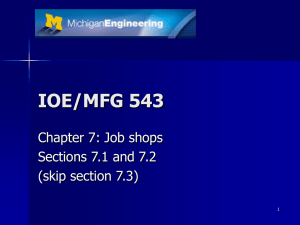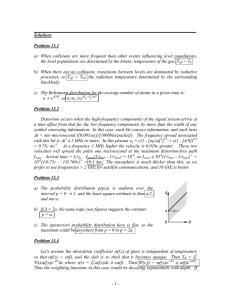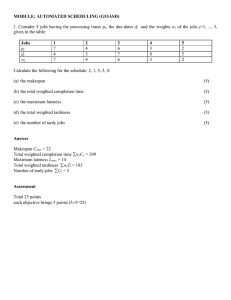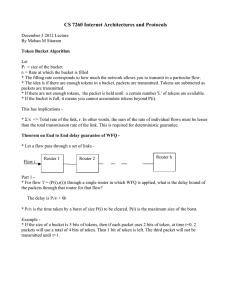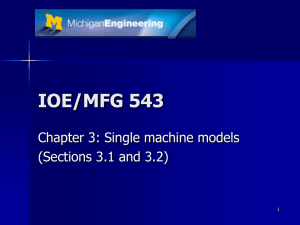18_jobshop.ppt
advertisement
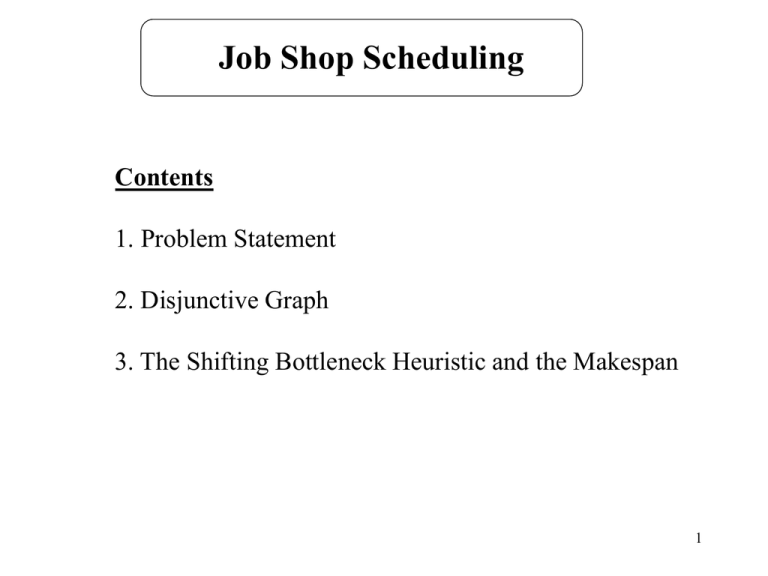
Job Shop Scheduling
Contents
1. Problem Statement
2. Disjunctive Graph
3. The Shifting Bottleneck Heuristic and the Makespan
1
Literature:
1. Scheduling, Theory, Algorithms, and Systems, Michael Pinedo,
Prentice Hall, 1995, or new: Second Addition, 2002
Chapter 6
or
2. Operations Scheduling with Applications in Manufacturing
and Services, Michael Pinedo and Xiuli Chao, McGraw Hill, 2000
Chapter 5
2
Problem Statement
Job shop environment:
•
•
•
•
•
•
m machines, n jobs
objective function
each job follows a predetermined route
routes are not necessarily the same for each job
machine can be visited once or more than once (recirculation)
NP hard problems
3
Disjunctive Graph
Example of a job shop problem: 4 machines and 3 jobs
1,1
S
2,2
2,1
1,2
1,3
3,1
4,2
2,3
3,2
T
4,3
4
Jm | | Cmax
(i, j)
processing of job j on machine i
pij
processing time of job j on machine i
G = (N, AB)
(i, j)N all the operations that must be performed on the n jobs
A
conjunctive (solid) arcs represent the precedence relationships
between the processing operations of a single job
B
disjunctive (broken) arcs connect two operations which
belong to two different jobs, that are to be processed on the
same machine, they go in opposite directions
• Disjunctive arcs form a clique for each machine.
• Clique is a maximal subgraph in which all pairs of nodes are
connected with each other.
• Operations in the same clique have to be done on the same machine.
5
How to construct a feasible schedule?
Select D - a subset of disjunctive arcs (one from each pair) such
that the resulting directed graph G(D) has no cycles.
Graph G(D) contains conjunctive arcs + D.
D represents a feasible schedule.
A cycle in the graph corresponds to a schedule that is infeasible.
Example
invalid
h,j
i,j
machine i
machine h
i,k
h,k
j
k
k
j
6
10
1,1
8
2,1
3,1
4
0
S
0
8
2,2
1,2
3
4,2
5
3,2
6
T
3
0
1,3
4
2,3
7
4,3
• The makespan of a feasible schedule is determined by the longest path
in G(D) from S to T.
• Minimise makespan: find a selection of disjunctive arcs that
minimises the length of the longest path (the critical path).
7
The Shifting Bottleneck Heuristic and the Makespan
Idea:
• A classic idea in nonlinear programming is to hold all but one
variable fixed and then optimise over that variable. Then hold all but
a different one fixed, and so on.
• Furthermore, if we can do the one-variable optimisation in order
of decreasing importance, there is better hope that the local optimum
so found will be the global one, or close to it.
• In job shop problems fixing the value of variable means fixing
the sequence in which jobs are to be processed on a given machine.
8
Iteration
M
set of m machines
M0 M machines for which sequence of jobs has already been
determined in previous iterations
Analysis of machines still to be scheduled
i{M-M0}
S
Define a
single-machine
problem 1 | rj | Lmax
for machine i
i,j
Jobs
pij
rij
dij
...
pij
T
j
pij
longest path from S to (i,j)
Cmax(M0) – longest path
from (i,j) to T + pij
...
9
Bottleneck selection
• A machine k with the largest maximum lateness is a bottleneck.
Lmax (k ) max ( Lmax (i ))
i{ M M 0 }
1. Schedule machine k according to the sequence which minimises
the corresponding Lmax (single-machine problem).
2. Insert all the corresponding disjunctive arcs in the graph.
3. Insert machine k in M0.
Cmax(M0 k) Cmax(M0) + Lmax(k)
10
Resequencing of all machines scheduled earlier
Aim: to reduce the makespan
Do for each machine l{M0 - k}
delete the disjunctive arcs associated with the machine l
formulate a single machine problem for the machine l and
find the sequence that minimises Lmax(l)
Insert the corresponding disjunctive arcs.
11
Shifting Bottleneck Algorithm
Step 1. Set the initial conditions
M0 = set of scheduled machines.
Graph G is the graph with all the conjunctive arcs and
no disjunctive arcs.
Set Cmax() equal to the longest path in graph G.
Step 2. Analysis of the machines still to be scheduled
Solve the simple problem for each machine still to be scheduled:
formulate a single machine problem with all operations subject to
release dates and due dates.
Step 3. Bottleneck selection
The machine with the highest cost is designated the bottleneck.
Insert all the corresponding disjunctive arcs in graph G.
Insert machine which is the bottleneck in M0 .
12
Step 4. Resequencing of all the machines scheduled earlier
Find the sequence that minimised the cost and insert the
corresponding disjunctive arcs in graph G.
Step 5. Stopping condition
If all the machines are scheduled (M0 = M) then STOP
else go to Step 2.
13
Example.
Jobs
1
2
3
Machine
Sequence
1, 2, 3
2, 1, 4, 3
1, 2, 4
Procesing Times
p11=10, p21=8, p31=4
p22=8, p12=3, p42=5, p32=6
p13=4, p23=7, p43=3
10
1,1
8
2,1
3,1
4
0
S
0
8
2,2
1,2
3
4,2
5
3,2
6
T
3
0
1,3
4
2,3
7
4,3
14
Iteration 1.
M0 =
Cmax()=22
S
10
1,1
8
2,1
3,1
4
0
0 2,2
8
1,2
3
4,2
5
3,2
6
T
3
0
1,3
4
3
4
0
12
Lmax(1, 2, 3) = max {0, 2, 5} = 5
Lmax(1, 3, 2) = max {0, 2, 6} = 6
Lmax(2, 1, 3) = max {0, 11,...} >11
Lmax(2, 3, 1) = max {0, 3, 15} = 15
Lmax(3, 1, 2) = max {-8, 4, 6} = 6
Lmax(3, 2, 1) = max {-8, 0, 15} = 15
2,3
7
4,3
Machine 1
Jobs
p1j
r1j
d1j
1
10
0
10
2
3
8
11
1,2,3 Lmax(1)=5
15
10
1,1
8
2,1
3,1
4
0
S
0 2,2
8
1,2
3
4,2
5
3,2
6
T
3
0
4
1,3
2,3
7
4,3
Machine 2
Jobs
p2j
r2j
d2j
1
8
10
18
2
8
0
8
2,3,1 Lmax(2)=5
3
7
4
19
Lmax(1, 2, 3) = max {0, 16, 14} = 16
Lmax(1, 3, 2) = max {0, 6, 25} = 25
Lmax(2, 1, 3) = max {0, 0, 6} = 6
Lmax(2, 3, 1) = max {0, -4, 5} = 5
Lmax(3, 1, 2) = max {-8, 1, 19} = 19
Lmax(3, 2, 1) = max {-8, 7, 5} = 7
16
10
1,1
8
2,1
3,1
4
0
S
0 2,2
8
1,2
3
4,2
5
3,2
6
T
3
0
1,3
4
2,3
7
4,3
Machine 3
Jobs
p3j
r3j
d3j
1
4
18
22
2
6
16
22
Lmax(1, 2) = max {0, 6} = 6
Lmax(2, 1) = max {0, 4} = 4
Lmax(3)=4
17
10
1,1
8
2,1
3,1
4
0
S
0 2,2
8
1,2
3
4,2
5
3,2
6
T
3
0
1,3
4
2,3
7
4,3
Machine 4
Jobs
p4j
r4j
d4j
2
5
11
16
3
3
11
22
Lmax(2, 3) = max {0, -3} = 0
Lmax(3, 2) = max {-8, 3} = 3
Lmax(4)=3
18
Lmax(2)=5
2,3,1
Lmax(1)=5
1,2,3
Lmax(3)=4
Lmax(4)=3
Machines 1 and 2 are bottlenecks.
Machine 1 is chosen as a bottleneck!
19
10
1,1
0
2,1
3,1
4
10
0
S
8
8
2,2
1,2
3
4,2
5
3
0
1,3
3,2
6
T
3
4
2,3
7
4,3
Cmax({1}) = Cmax() + Lmax(1) = 22 + 5 = 27
20
Iteration 2.
M0 = {1},
Cmax({1})=27
10
1,1
0
2,1
3,1
4
10
0
S
8
8
2,2
3
5
4,2
3
0
1,3
Machine 2
1,2
3,2
6
T
3
4
Jobs
p2j
r2j
d2j
7
2,3
1
8
10
23
2
8
0
10
4,3
3
7
17
24
2,1,3 Lmax(2)=1
21
Machine 3
Machine 4
Jobs
p3j
r3j
d3j
1
4
18
27
2
6
18
27
1,2 or 2,1 Lmax(3)=1
Lmax(4)=0
Machines 2 and 3 are bottlenecks.
Machine 2 is chosen as a bottleneck!
22
10
1,1
2,1
10
0
0
8
2,2
3,1
4
8
8
S
8
1,2
3
4,2
5
3
0
1,3
3,2
6
T
3
4
2,3
7
4,3
Cmax({1,2}) = Cmax({1}) + Lmax(2) = 27 + 1 = 28
Can we decrease Cmax({1,2}) ?
Will resequencing machine 1 give any improvement ?
23
1,1
8
0
8
2,2
3,1
4
8
1,2
3
4,2
5
3
0
1,3
1
10
0
10
2
3
8
17
3,2
6
T
3
4
Machine 1
Jobs
p1j
r1j
d1j
8
2,1
10
0
S
10
3
4
0
18
original sequence: 1,2,3
2,3
7
4,3
Cmax({1,2}) = 28
Lmax(1, 2, 3) = max {0, -4, -1} = 0
Lmax(1, 3, 2) = max {0, -4, 0} = 0
Lmax(2, 1, 3) = max {-6, 11,7} =11
Lmax(2, 3, 1) = max {-6, -3, 15} = 15
Lmax(3, 1, 2) = max {-14, 4, 0} = 4
Lmax(3, 2, 1) = max {-14, 2, 15} = 15
Resequencing machine 1 does not give any improvement.24
Iteration 3.
M0 = {1,2}
Cmax({1,2})=28
Machine 3
Machine 4
Jobs
p3j
r3j
d3j
1
4
18
28
2
6
18
28
1,2 or 2,1 Lmax(3) = 0
Lmax(4) = 0
No machine is a bottleneck!
25
10
1,1
2,1
10
0
0
8
2,2
3
1,2
5
4,2
3,2
7
2,3
1
2
2
T
4,3
3
1
3
Machine 3
2
Machine 4
1
2
5
6
3
4
1,3
Machine 2
4
3
0
Machine 1
3,1
8
8
S
8
10
15
3
20
25
30
26
t
